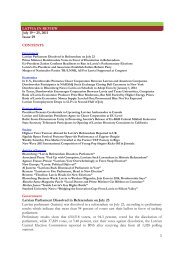Latvian Folk Dress - Latvijas Institūts
Latvian Folk Dress - Latvijas Institūts
Latvian Folk Dress - Latvijas Institūts
You also want an ePaper? Increase the reach of your titles
YUMPU automatically turns print PDFs into web optimized ePapers that Google loves.
<strong>Latvian</strong><br />
<strong>Folk</strong><br />
<strong>Dress</strong><br />
<strong>Latvian</strong> peasants in the drawings of J. C. Brotze,<br />
end of the 18th century.<br />
18th-19th century<br />
We have most knowledge of <strong>Latvian</strong> ethnic dress of the late 18th and<br />
19th centuries as most records and items of festive clothing have been<br />
preserved from this period. This also helps to understand the traditions<br />
of previous generations, as a large part of 19th century festive clothing<br />
was not created during the lifetime of just one generation.<br />
Written records from the 18th century affirm that the most common<br />
colour of <strong>Latvian</strong> peasant’s dress was the natural white and grey of<br />
linen and wool. The records suggest that the favourite colours of<br />
<strong>Latvian</strong>s and Lithuanians were white or light grey, and thus they could<br />
be distinguished from their neighbours, as Russians preferred bright<br />
colours, while Estonians dressed in black. Until the beginning of the<br />
19th century, when natural dyes were still used, most <strong>Latvian</strong>s’ clothes<br />
were natural grey, while for decoration they kept to the century-old<br />
traditional four-colour scheme of blue, red, yellow, and green.<br />
The most significant source of information on <strong>Latvian</strong> peasants’ dress<br />
in the late 18th and early 19th centuries is drawings and descriptions<br />
by Johan Christoff Brotze (1742-1823). In his drawings he depicts local<br />
people, showing not only festive clothing, but also work clothing.<br />
•During the 19th century, linen tunic-shaped shirts were still the main<br />
garment worn. Work shirts still looked very similar to the ancient ones.<br />
For festive occasions, however, there were now variations of collars, cuts,<br />
and embroidery (most often in white, sometimes red and very rarely,<br />
black). Shirts were pinned with small smooth or relief ring-shaped or<br />
heart-shaped brooches. Sometimes there was a row of brooches down<br />
the front opening of the shirt. Women’s linen shirts usually consisted of<br />
two parts. The visible upper part was made of fine linen cloth, but the<br />
lower part that was hidden under the skirt was made of crude linen.<br />
Above the shirt, <strong>Latvian</strong> women wore long skirts, coats of various length<br />
(longer in the 18th century and waist-length coats or vests in the 19th<br />
century), and woollen shawls instead of cloaks.<br />
Often the only jewellery worn by <strong>Latvian</strong> women were silver brooches<br />
with thimble-like bubbles, red glass “stones” or beads and numerous<br />
tiny silver “leaves”. These were worn on the chest, usually as fasteners for<br />
shawls. Young girls wore crowns that were made of cardboard covered<br />
in cloth and embroidered with glass beads, tinsel, and thin brass rings.<br />
<strong>Latvian</strong>s did not often wear amber beads although the material was<br />
easily accessible on the shores of the Baltic Sea. Rather they preferred<br />
glass beads and silver coins. There was no tradition of wearing earrings<br />
in the entire territory of Latvia.<br />
At the turn or the 19th century, men wore homespun coats, mostly of<br />
a natural grey colour, that were decorated with red, green or blue cord<br />
and matching appliqué on the sleeves. Buttons were used for fastening<br />
the coat.<br />
In summer, linen overcoats were worn.<br />
Men’s clothes of dark blue, brown or natural black appeared in the<br />
second half of the 19th century when industrially-made cloth was used<br />
for festive clothing. Men wore vests for special occasions. Both long and<br />
down-to-the knee trousers were in use.<br />
12 13






